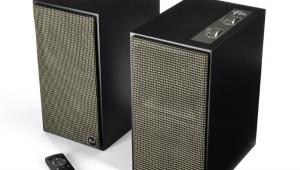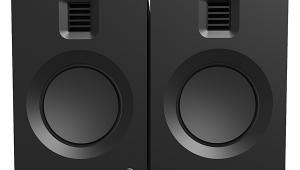Angstrom Suono 600SD Speaker System Page 2
The Suono speakers turned out to be sensitive to source material. I played three movies and had three different experiences, which I’ll list in order of quality. The best of the bunch was the vampire (and more) extravaganza Van Helsing on Blu-ray with DTS-HD Master Audio. The relentlessly epic soundtrack got consistently epic treatment from the Suonos. In the opening scene, Dr. Frankenstein’s castle is under siege by villagers. It sounded huge and immersive, and it set the tone for the rest of the movie. By the minimal standards of many on-wall speakers, the Suonos were miracle workers. Dialogue was never a problem; the phantom center was clear and bright. Since movie mixes often use the center for effects, some of those were a bit bright, such as the high whine of the rotary blades that burst out of Hugh Jackman’s fingers at moments of stress.

In Law Abiding Citizen, Jamie Foxx plays a prosecutor who takes on a mad vigilante. For the Suono system, it was an easy ride. The DVD’s Dolby Digital 5.1 soundtrack may not have been the ideal delivery method. Still, when it was delivered via these soft-dome tweeters, it was full and rich, with a high comfort level. There was a slight diffusion and side-to-side tonal shift in the front that was noticeable with voices, but this didn’t hamper intelligibility. Challenged by exploding cars, the 10-inch ALFT-10S sub didn’t exactly shake the floor, but it also didn’t bloat when I fed it aggressive low-frequency material.
The 1998 remake of Godzilla wasn’t an entirely comfortable experience, despite the Blu-ray Disc’s lossless DTS-HD Master Audio soundtrack. Effects were crude and hot. They triggered me to make early and sizable reductions in the master volume. This left dialogue a little too low, so the remote was never far from my hand.
I Often Dream in Surround
The Suonos have a strongly outlined midrange and a slight treble emphasis, especially in the phantom center. This came to the foreground in the stereo Dolby Digital soundtrack of Robyn Hitchcock’s DVD/CD set I Often Dream of Trains in New York, a live celebration of his landmark 1984 album I Often Dream of Trains. Hitchcock’s voice has a slightly piercing top end. Through these speakers, it flew out of the phantom center like a laser beam, and it burned psychedelic patterns into the wall behind me. This was no hazy approximation of a voice in a phantom center. It was an exceedingly well-focused treatment of a familiar voice. Since the Dolby Digital soundtrack was stereo, not 5.1, the Dolby Pro Logic II Music mode came into play. It created the center-channel information that the Suono system delivered.
Eric Clapton and Steve Winwood’s Live from Madison Square Garden Blu-ray lets you choose between two soundtracks: DTS or PCM stereo. While I don’t expect miracles from arena-rock recordings, the lack of a lossless surround soundtrack was a missed opportunity. Still, the DTS soundtrack offered a fully realized soundfield. Some of the principal attractions—Clapton’s Fender Stratocaster and both men’s voices—were located in the front speakers without being entirely confined to them. Winwood’s Hammond organ floated a little closer to the surrounds. When Winwood joined Clapton on guitar, their leads intertwined gracefully, and (to their credit) the Suono speakers never blurred them together. The rhythm section emerged in good form from the sub. It offered even bass lines and enough thump to provide a surefooted rhythmic framework for the songs and soloists.
On the Chandos CD, Fauré Piano Quartets, pianist Kathryn Stott joins the Hermitage String Trio (violin, viola, cello). Here, the unevenness that the test tones hinted at became too obvious. In Dolby Pro Logic II Music mode, the soundfield was vague in front and overpowering in the rear. Diffusion afflicted everything, especially the piano. And the center image, including the piano, was weaker than it was in any other demo. It pulled the center image to the sides and the back. However, in stereo, all the instruments suddenly snapped into tighter focus. While their deployment was limited to a relatively narrow front soundstage, they were more physically present, solid, and coherent. The impact of the change on me was physical—I started to wiggle my foot, carried away by the music’s surging rhythms. Stereo worked better even when I moved off axis, which gave me more mobility on the sofa.
Angstrom has come up with an alternative solution for the center-channel blues, with a phantom center solution that really works. While it can handle movies and music well, its strengths lean slightly toward the movie end of things, emphasizing the clarity of the center over the seamlessness of the soundfield. Its performance hinges on the quality of source material—this is a revealing set of speakers. The fabric-wrapped enclosures are quietly good-looking, with nothing shiny to reflect light and distract attention from the screen. If you want an on-wall audio solution that will complement a flat-panel TV, and you’re dead set against hanging a center speaker—either in the right place or the wrong place—then put this on your short list of must-hears.





























































